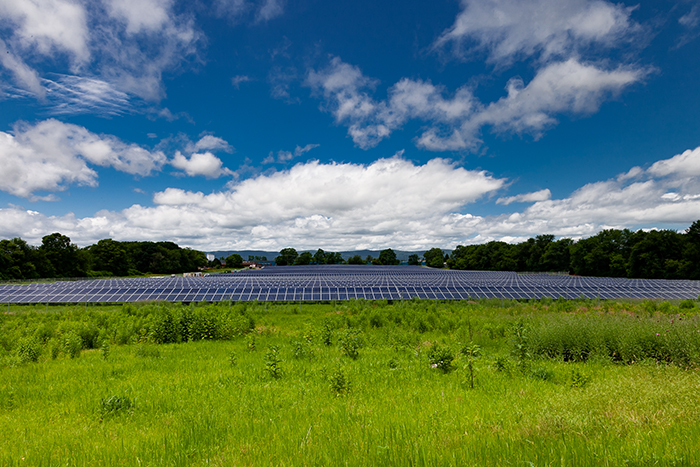Dickinson College Achieves Carbon Neutrality

Combined with Dickinson’s Tesla-designed-and-built 3-megawatt solar field (pictured) and multiple other solar arrays on campus, the new power purchase agreement eradicates approximately 75% of Dickinson’s electricity-related emissions.
First College or University in Pennsylvania to Achieve Carbon Neutrality
by Craig Layne
Dickinson College announced it has achieved what fewer than 10 colleges and universities in the nation have accomplished—it is carbon neutral—a goal established in 2007, when the college became an early signatory of the Presidents Climate Leadership Commitments and shortly after resolved to reduce its net carbon emissions to zero by the year 2020. It is the first college in Pennsylvania to achieve carbon neutrality and has led sustainability rankings in higher education throughout the pursuit of neutrality.
“Through more than a decade of collaborative effort, the entire Dickinson community has made this ambitious achievement a reality,” said President Margee Ensign. “Sustainability is one of the pillars of a Dickinson education. We are meeting our civic obligation to the future by taking responsible, scientifically supported actions to slow climate change now.”
Dickinson achieved its carbon neutrality goal by cutting its own greenhouse gas emissions 25 percent from its 2008 levels and financing emission reductions by others through the purchase of carbon offsets. From this year forward, all the activities included in the college’s carbon footprint—like heating and cooling the campus, use of vehicles and air travel—will result in zero net emissions of greenhouse gases to the atmosphere.
“The single biggest project we’ve done to reduce our carbon emissions is our 3-megawatt solar field, which has reduced 10% of our total carbon emissions,” said Ken Shultes, associate vice president for sustainability and facilities planning. “Dickinson is also part of the largest solar power purchasing agreement among independent colleges in the nation. In total, Dickinson’s solar projects account for more than 65% of the college’s electricity consumption.”
The college concentrated on efficiency improvements to heating, cooling and electrical systems across campus, reducing its energy use per square foot of building space by more than 10%, even as the campus grew by about 15% over the decade. This achievement was assisted by designing new buildings to meet Leadership in Energy and Environmental Design (LEED) Gold or Platinum standards. Dickinson also focused on encouraging sustainable behaviors among students, faculty and staff through education and outreach programs. On the sustainable transportation front, Dickinson added three dual-port electric vehicle (EV) charging stations on campus in 2020 to support the purchase and use of these low-emission vehicles by the extended college community.
“Dickinson has committed to make climate change a major focus of both our academic curriculum and life on campus,” said Neil Leary, associate provost and director of Dickinson’s Center for Sustainability Education. “Students are preparing for leadership in the wider world with hands-on approaches to climate science, risks, ethics, solutions, policies and economics while living in a community that weaves sustainable practices into everything we do. It’s a living example of Dickinson’s dedication to providing a useful education for the common good.”
Dickinson is an award-winning national leader in sustainability education and best practices. In addition to receiving accolades from the Association for the Advancement of Sustainability in Higher Education (AASHE), The Princeton Review, Sierra Magazine and others, the college has trained faculty from partner institutions on teaching about climate change and received a major grant from NASA for this work. Dozens of projects and initiatives on and off campus connect sustainability projects to the classroom and community. These include the college’s USDA-certified organic farm, a living laboratory for food studies and science programs; the on-campus Handlebar Bicycle Cooperative; the Dickinson-based Alliance for Aquatic Resource Monitoring, which trains citizens to test the health of their local waterways; and the Center for Sustainable Living, or “Treehouse,” a student residence focused on sustainable living practices.
“We are not stopping with our 2020 goal,” said Leary. “Our critical work will continue as we make deeper cuts into our greenhouse gas emissions and continue to finance reduction by others, and we are committed to sharing our knowledge and resources with other institutions who want to join us on this path.”
TAKE THE NEXT STEPS
Published April 7, 2020